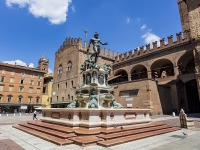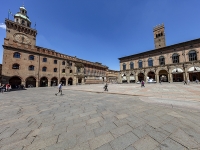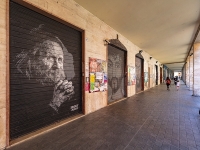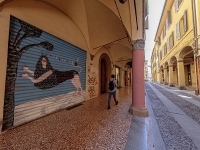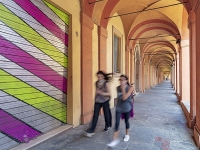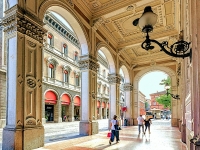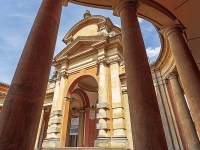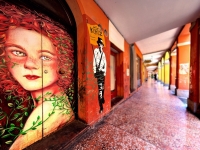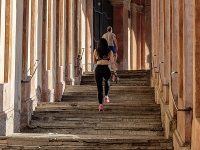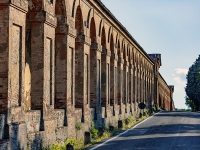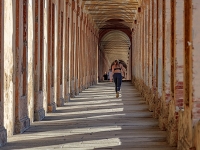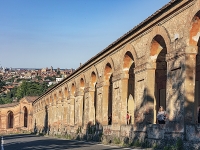Reisen
Bologna porticoes have been nominated as a UNESCO World Heritage Site.
Bologna UNESCO World Heritage Site
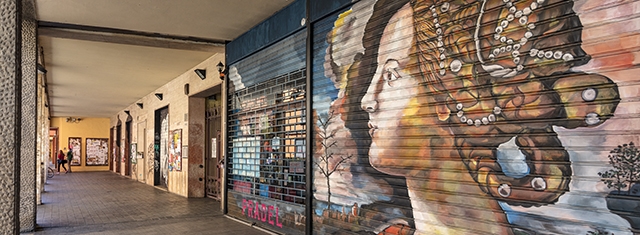
porticos of Bologna Unesco World Heritage Site (Quelle: Roberto Magni by Foto ReD Photographic Agency)
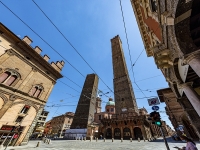
Bologna the two towers (Garisenda and Asinelli)
(Quelle: Roberto Magni by Foto ReD Photographic Agency)
(Quelle: Roberto Magni by Foto ReD Photographic Agency)
This is also an excellent opportunity for Bologna to relaunch tourism
In the late middle ages, the University of Bologna - the oldest in Europe - started to grow rapidly: students of medicine, authors, intellectuals and men of letters headed to Bologna to live the vibrant and instructive community that was then flourishing in this town.
As more and more people settled down in town, the need to expand housing spaces grew larger. In fact, the old father of the portico is the sporto, which was simply a protruding wooden structure aimed at broadening housing spaces for people living in the upper floors of buildings. These sportos were initially built abusively and, as they became larger and heavier, they started to require columns to uphold them: these new promiscuous private-yet-public spaces became the porticoes that we walk under today.
Soon, while other towns banned the porticoes, the city council in Bologna decided to lay down some official rules and made porticoes compulsory as a public space.
With no doubt, the most famous arcades in town are the ones connecting porta Saragozza to the Sactuary of San Luca, up the Colle della Guardia (literally, the "hill of the guardian"). Climbing up the hill on one's knees while praying used to be a common habit in ancient times and was thought to be a miraculous practice. Nowadays, most people use this covered path to simply walk, jog or run up the hill, mostly to keep fit.
Join our Bologna Food Walking Tour to walk through the historical center of Bologna with an expert local host that will unveil more secrets of Bologna's ancient traditions and culture.
Italy has nominated the distinctive porticos of Bologna as a Unesco World Heritage Site, calling them one of the north-eastern city's defining features.
At a meeting of Italy's national Unesco committee on Tuesday, Bologna's portici - covered walkways - were selected as the latest Italian nominee for World Heritage status, an honour already conferred on 55 of the country's unique historic sites.
Mayor Virginio Merola called the nomination a "great and well-deserved achievement for Bologna".
The colonnades, which stretch for more than 60 kilometres around the centre of Bologna and its outskirts, are the result of nine centuries of urban planning, Italy's Culture Ministry said in a statement, calling them "both an architectural and a social model, a place of integration and exchange where residents, visitors and students live and share ideas and time".
Ever since 1100, when the growth of the University led to the need for new urban spaces, the porticoes have become private and public locations where people can socialise and trade, an open-air salon symbol of Bologna“™s hospitality.
By taking a stroll through the city, you can encounter and appreciate various types of porticoes. From the wooden ones, such as the 13th century casa Isolani in strada Maggiore and the porticoes of via Marsala, to the 14th century "beccadelli“, semi-porticoes without columns, such as the one present on the rear façade of Palazzo d'Accursio and in Palazzo Ghisilardi-Fava. Very well known is the very high portico “dei Bastardini“ in via D“™Azeglio, so called because under its vaults, until 1797, the orphanage was located, as well as the portico of the Archiginnasio, known as “Pavaglione“.
The widest portico of the city is the four-sided portico of the basilica of S.Maria dei Servi in Strada Maggiore, designed at the end of the 14th century, the highest is in via Altabella where the archiepiscopal building has a porch touching 10 metres, and the narrowest, with its 95 cm, is located in via Sanzanome.
Beyond the avenues the long porticoed path of via Saragozza begins, which is the start of the most famous portico in the city as well as the longest in the world, leading to the Sanctuary of the Madonna of San Luca. From the first arch of porta Saragozza (Bonaccorsi), you arrive halfway to the Arco del Meloncello and then go up to Monte della Guardia. The portico is made up of 664 arches and measures almost 4 km.
Arco del Meloncello Zaragoza - San Luca
Built in 1732 on a design by Carlo Francesco Dotti, the Arco del Meloncello begins the stretch of portico that goes up to the Sanctuary of San Luca, interspersed with fifteen chapels depicting the Mysteries of the Rosary.
At the center of the entablature stands the copper coat of arms of the Monti Bendini family, demonstrating the great economic commitment used in the construction of the portico of San Luca.
Bologna is often nicknamed la dotta (the Learned), la grassa (the Fat) and la rossa (the Red): It is probably best known as the home of the University of Bologna, the oldest continuously operating university in the western world; for its reputation for culinary excellence and traditions, including being the birthplace of Italian classics like tortellini and Ragù Bolognese; and for its leftist, anti-fascist politics and progressive values“”along with the characteristic terracotta-red color of its buildings.
But architecturally, it is the impressive, well-preserved porticoes (portici, in Italian) that have come to define the cityscape. These stunning covered walkways, located throughout the Medieval historic center, stretch some 25 miles in length. Constructed between the 11th to 20th centuries, each portico seems to be one-of-a-kind, reflecting the diversity of styles and materials used over different eras.
These iconic structures offer a graphic, visual representation of Bologna“™s rich history. Like many of the impressive palaces, museums, municipal buildings, and two leaning towers located off the streets and alleys that fan out from the Piazza Maggiore (the city“™s public square and virtual living room), the porticoes lay witness to the city“™s longstanding commitment to historic preservation and restoration.
Some of the first porticoes were built to add square footage to dwellings without the inhabitants having to pay taxes as they would for adding additional floors. Because the structures jutted out over the street, this space wasn“™t included in tax calculations. Another harbinger of change: New laws in the 1500s prohibited the building of wooden porticoes so ones built of brick and stone proliferated.
The porticoes are of practical significance, too. In summer, they provide protection from sun and rain; in winter, protection from snow and winds.
The longest one in Bologna (and in the world), the Portico di San Luca, has religious symbolism in addition to providing a protected path to the Sanctuary of the Madonna di San Luca.
Even now, the porticoes of Bologna continue to provide affordable housing for the many university students who live in the upper-floor apartments overhead.
A nomination stirs excitement
While other cities in Europe (such as Innsbruck, Berne and Madrid) have buildings with porticoes, none have as many as Bologna. Moreover, in no other place are they considered a distinctive feature of an urban setting. The nomination notes that some of these structures have survived more than 1000 years, even withstanding the ravages of war, because of steadfast public and governmental support.
Currently, Italy holds the title of having the largest number of UNESCO World Heritage Sites (55) but this would be the first in Bologna, a city that blends its Medieval history and architecture with contemporary sensibilities“”one that many Italians and visitors from abroad consider among the most beautiful in Italy.
In 2006, Bologna was designated a UNESCO City of Music for its contributions to classical music, opera, and dance, and prominence in pop music. During that same year, the porticoes were put on a tentative list awaiting nomination.
weitere Informationen: https://www.redmagazine.red
Für den Artikel ist der Verfasser verantwortlich, dem auch das Urheberrecht obliegt. Redaktionelle Inhalte von GDN können auf anderen Webseiten zitiert werden, wenn das Zitat maximal 5% des Gesamt-Textes ausmacht, als solches gekennzeichnet ist und die Quelle benannt (verlinkt) wird.

